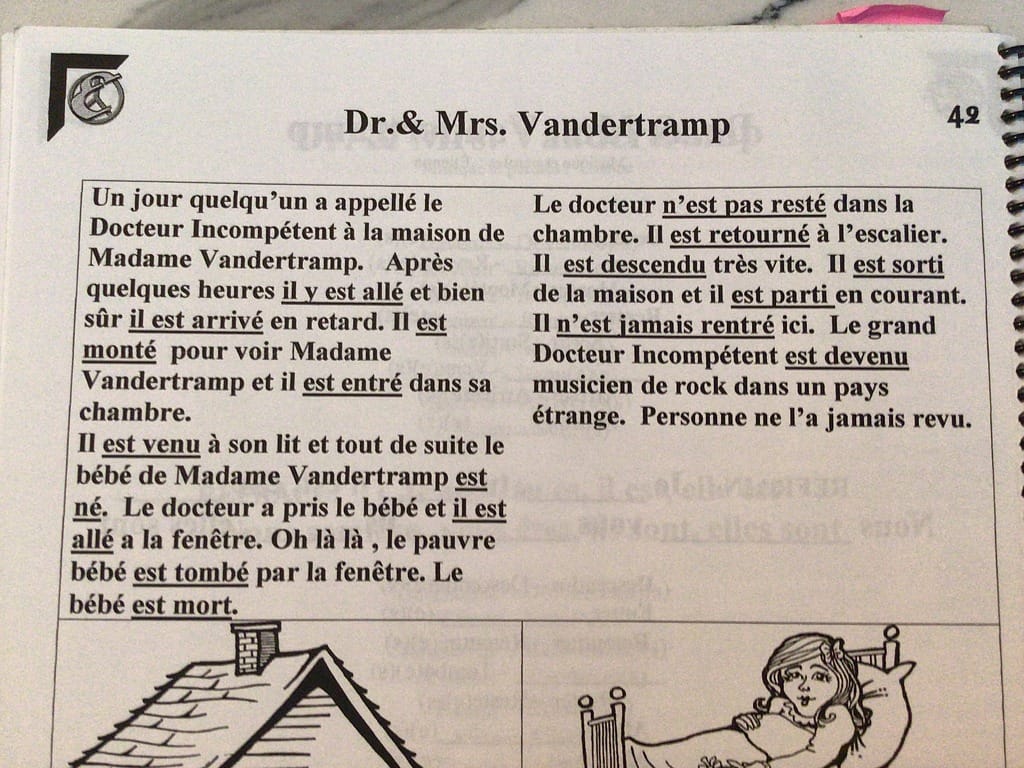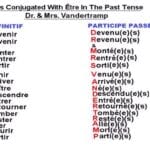Hey there, language enthusiasts! Ready to conquer the French passé composé? This guide, featuring the memorable Dr. & Mrs. Vandertramp mnemonic device, will equip you to navigate this essential past tense with confidence. Let’s dive in!
Decoding Dr. & Mrs. Vandertramp: A Mnemonic for Movement
French verbs can be tricky, especially when forming the past tense. The passé composé, a common way to express past actions, often uses a helping verb (an auxiliary verb). While most verbs use avoir (to have), some require être (to be). This is where Dr. & Mrs. Vandertramp come in—a mnemonic device designed to make remembering these être verbs easier.
The Vandertramp system focuses on verbs typically representing movement or a change in state. These 17 verbs, each represented by a letter in “Dr. & Mrs. Vandertramp,” form the core of this mnemonic:
| Letter | Verb (Infinitive) | English Meaning | Example of Change/Movement |
|---|---|---|---|
| D | Devenir | To become | Transforming into something new |
| R | Revenir | To come back | Returning to a place |
| M | Monter | To go up | Ascending, moving upward |
| R | Rester | To stay | Remaining in a location |
| S | Sortir | To go out | Exiting, leaving a place |
| V | Venir | To come | Arriving at a location |
| A | Aller | To go | Moving from one place to another |
| N | Naître | To be born | Entering the world, a fundamental change |
| D | Descendre | To go down | Moving downward, descending |
| E | Entrer | To enter | Going into a place |
| R | Retourner | To return/go back in | Re-entering, going back |
| T | Tomber | To fall | A sudden downward movement |
| R | Rentrer | To return/go back in | Returning home specifically |
| A | Arriver | To arrive | Reaching a destination |
| M | Mourir | To die | The ultimate change of state |
| P | Partir | To leave | Departing from a place |
| P | Passer | To pass | Moving from one state/place to another |
This mnemonic also includes variations of these core verbs (e.g., redevenir – to become again, remonter – to go back up). A simplified version, the “N-SPAM” method, focuses on five key verbs: Naître, Sortir, Partir, Aller, and Monter.
Learn more about Cynthia Applewhite, the renowned leader of Heaven’s Gate, and delve into the fascinating life and philosophies of this enigmatic figure.
Beyond Memorization: Understanding the Être Logic
While the Dr. & Mrs. Vandertramp mnemonic is a valuable tool, simply memorizing it isn’t enough. It’s essential to grasp the underlying logic: these verbs usually depict actions causing a change of location or state of being for the subject. For example, “to go” changes your location, while “to become” transforms your state of being.
Research suggests mnemonics can be beneficial, but practical application is key. Practice using these verbs in sentences to solidify your understanding. Ongoing linguistic discussion explores optimal grammar teaching methods, suggesting different approaches may suit different learners.
Furthermore, some linguists argue that overreliance on memorization may hinder a deeper understanding of why these verbs use être. They suggest focusing on the core concepts of movement or a change of state. This deeper understanding enables you to deduce the correct auxiliary verb, even if you forget a specific verb from the mnemonic.
Also, remember language constantly evolves. Ongoing research may refine our understanding of these grammatical rules. So, keep exploring and learning!
Discover the history of Dickerson Naylor Hoover, the law firm responsible for some of the most groundbreaking civil rights cases.
Key Considerations and Further Exploration
The Passé Composé and Auxiliary Verbs
The passé composé describes completed past events. It uses an auxiliary verb (être or avoir) and the past participle of the main verb. Dr. & Mrs. Vandertramp verbs are exceptions to the general rule of using avoir, employing être instead.
Agreement with Être
When using être, the past participle agrees in gender and number with the subject. This means the participle may change its form based on who performed the action. For instance, “Elle est allée” (She went) uses the feminine form of the past participle, while “Ils sont allés” (They went – masculine) uses the masculine plural form.
Limitations of Dr. & Mrs. Vandertramp
While highly useful, this mnemonic isn’t foolproof. It doesn’t encompass all être verbs; notably, reflexive verbs (e.g., se laver – to wash oneself), though conjugated with être, follow a different logic and are not included in the Vandertramp list. These verbs typically show an action performed by the subject on themselves, a distinct concept from movement or state change.
Moreover, native French speakers typically don’t use this device. It’s primarily a learner’s tool.
Exploring Verb Families
Considering verb families can enrich your understanding. For example, the venir family (including revenir, parvenir, etc.) largely adheres to the être rule, providing a broader pattern for application.
Visual and Interactive Learning
Visual aids like mind maps and interactive exercises can significantly boost comprehension and retention. Many online resources offer quizzes and practice activities to reinforce your learning.
By grasping the underlying principles of être conjugation and exploring these additional insights, you’ll move beyond rote memorization towards genuine mastery of the French passé composé. Keep practicing, and bon courage!













1 thought on “Mastering the Passé Composé with Dr. & Mrs. Vandertramp: A Comprehensive Guide”
Comments are closed.